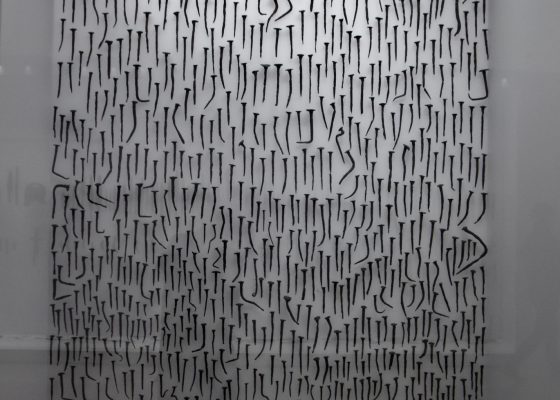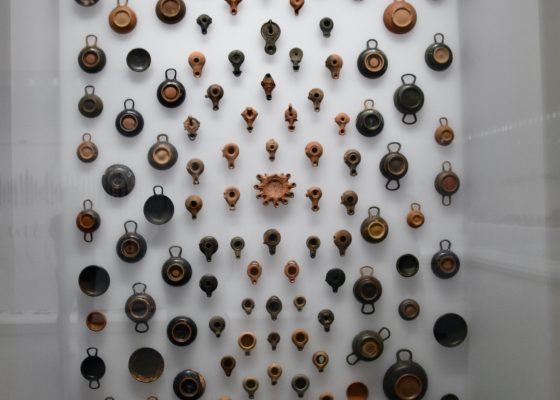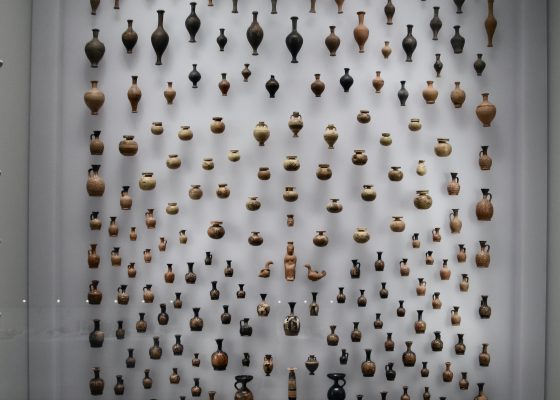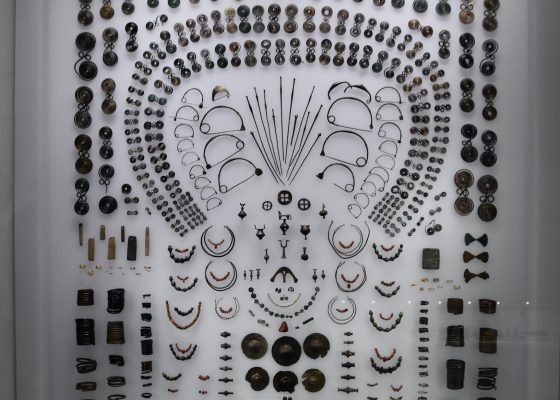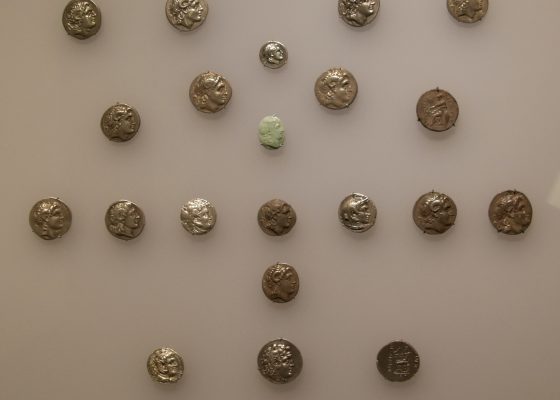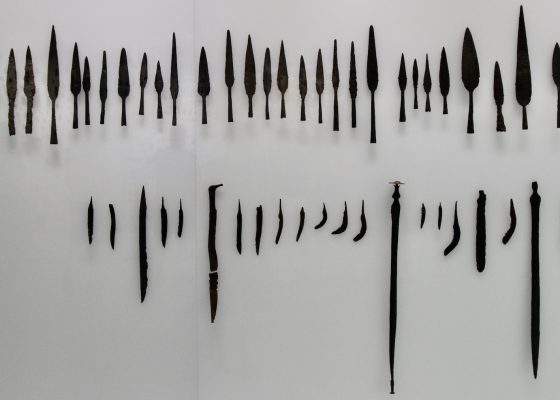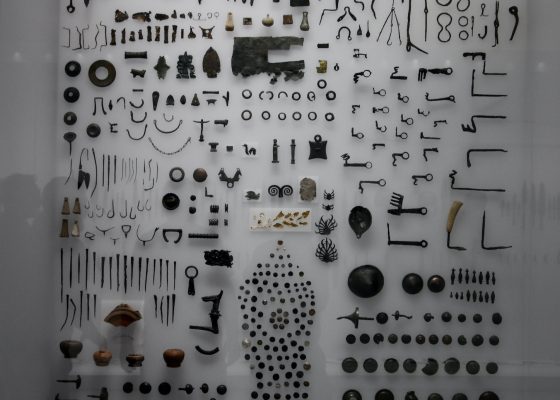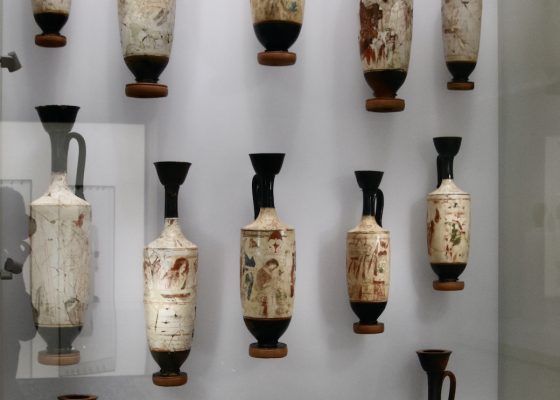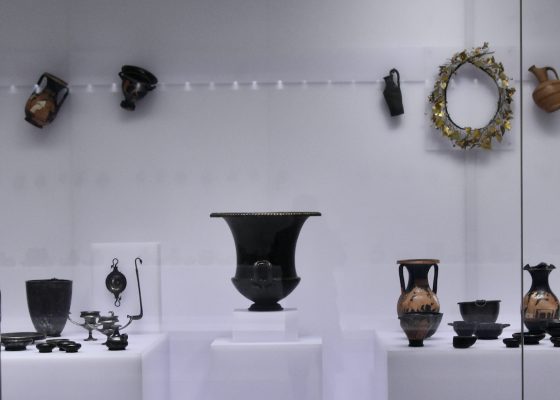Vergina – The Royal Tombs of Macedon
In the last post our Adventures Abroad Via Egnatia tour visited Pella, the birthplace of Alexander the Great and the principal city of the Macedonian Empire. Although the archaeological site was not much to look at, the Pella Museum was outstanding. In this post we’ll move to the nearby town of Vergina which is located near the ruins of Aigai, the original capital of Macedon and the site of the burials of dozens of Macedonian nobles including Philip of Macedon and Alexander the Great’s son, Alexander IV. The richness of the grave goods unearthed at Vergina rival those of any royal tombs, including even that of Tutankhamun. It’s a place I’ve long wanted to visit and today’s the day. Please join us and our estimable AA guide Victor Romagnoli as we visit the Royal Tombs of Macedon.
History of Aigai
There are traces of human settlement at present day Vergina since at least 3,000 BCE, but the Macedonian dynasty was founded by settlers from Argos of whom one, Perdiccas I is generally believed to be the one who first occupied the site which became Aigai around 650 BCE. Successive monarchs enlarged the city and were buried in a complex of royal tombs near the archaeological site which contains the largest palace ever built in ancient Greece along with accompanying temples, theatres and other major buildings. It was here that Philip II was assassinated in 336 BCE by one of his bodyguards while celebrating the marriage of his daughter Cleopatra, sister to Alexander. And it was here that Alexander was proclaimed King of Macedon and set out on his monumental but short, life’s journey to eternal greatness. Unfortunately for our group the archaeological site was closed as it had been since 2008, but the good news is that it reopened in January, 2024 and the next Via Egnatia tour no doubt will have the pleasure of visiting the place where these events occurred.
There was however, a fantastic consolation prize waiting for us in Vergina, the royal tombs. Near the remains of the palace is the Great Tumulus, one of four in what is a massive necropolis. It was constructed in the 3rd century BCE to protect the royal tombs from marauders and is similar in purpose to the barrows that are found throughout much of the world, especially Great Britain. It wasn’t until the 19th century that the visible ruins around Vergina were determined to be the site of ancient Aigai and the various tumuli the potential site of the unlooted graves of Macedonian nobles and maybe even Philip II. Although Alexander the Great was scheduled to be buried here, his body was kidnapped by one of his generals and taken to Memphis in Egypt where it was buried. He was later moved to Alexandria and was visited there by Julius Caesar and Augustus. Then some time after this his fabulous coffin disappeared and the search for it is akin to the Holy Grail in terms of what it would mean for the archaeologist who found it.

So while everyone knew they weren’t going to find Alexander at Vergina they might find his father, mother and son among others. For years every tomb found had been robbed with little of historic value left. Then in 1977 Greek archaeologist Manolis Andronicos made the greatest discovery since Howard Carter found the relatively unlooted tomb of Pharaoh Tutankhamun aka King Tut in 1922. It was the unopened tomb of a great noble who, after some disagreements initially, is now universally accepted as that of Philip II. While King Tut was a relatively inconsequential pharaoh who died at age 18, Philip II was one of the most important figures in the ancient world. And that wasn’t all. In 1978 the tomb of Alexander’s murdered son Alexander IV was discovered, also unopened.
These discoveries were so important that Greece immediately decided to leave the tombs in situ and build a museum displaying the items found in these tombs inside the Great Tumulus itself. The museum opened in 1993 and while the Great Tumulus was effectively dismantled during the construction process, it has been restored to look as close as possible to the original.
In 1996 the palace archaeological site and royal tombs were inscibed as a UNESCO World Heritage Site with this description:
The city of Aigai, the ancient first capital of the Kingdom of Macedonia, was discovered in the 19th century near Vergina, in northern Greece. The most important remains are the monumental palace, lavishly decorated with mosaics and painted stuccoes, and the burial ground with more than 300 tumuli, some of which date from the 11th century B.C. One of the royal tombs in the Great Tumulus is identified as that of Philip II, who conquered all the Greek cities, paving the way for his son Alexander and the expansion of the Hellenistic world.
So here I am at the entrance to the Great Cumulus – come along and I’ll show you what’s inside.
The Royal Tombs of Vergina
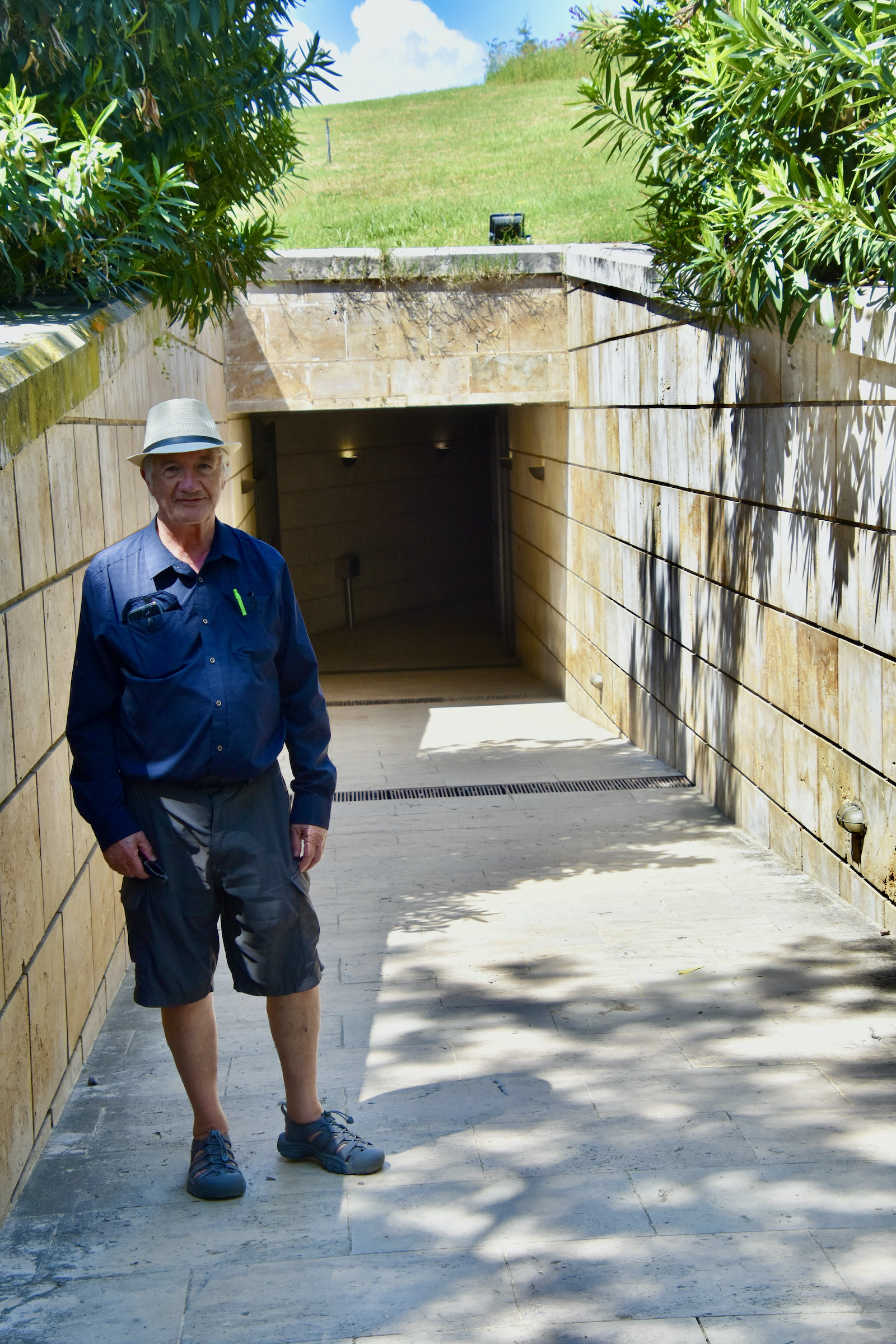
Inside there is a dedicated pathway through the tomb museum and the light is kept very low so getting good pictures that are not blurry is a challenge. However, I’ll do my best.
The museum has literally hundreds of items that are in incredibly good shape considering their age. Look closely at the redware krater on the left. It looks like it was painted yesterday and not almost 2,500 years ago.
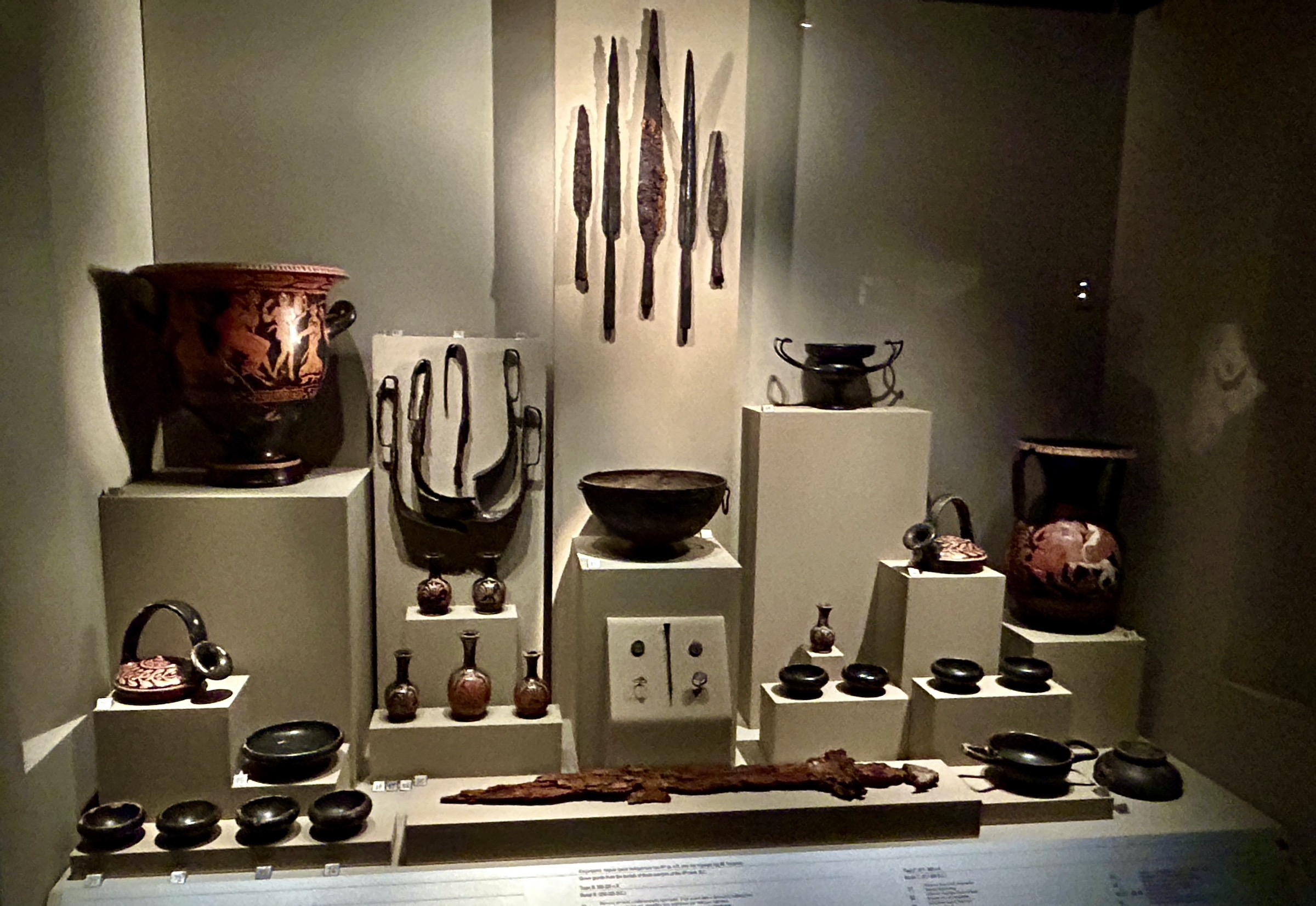
Before getting to the Royal Tombs there are a series of grave markers of Macedonian nobles. This is one dedicated to Antigonus and dates from roughly 340 to 330 BCE which would make him a contemporary of Philip II. It is not the same Antigonus who was one of the three Alexandrian generals who fought for control of the empire after his death.
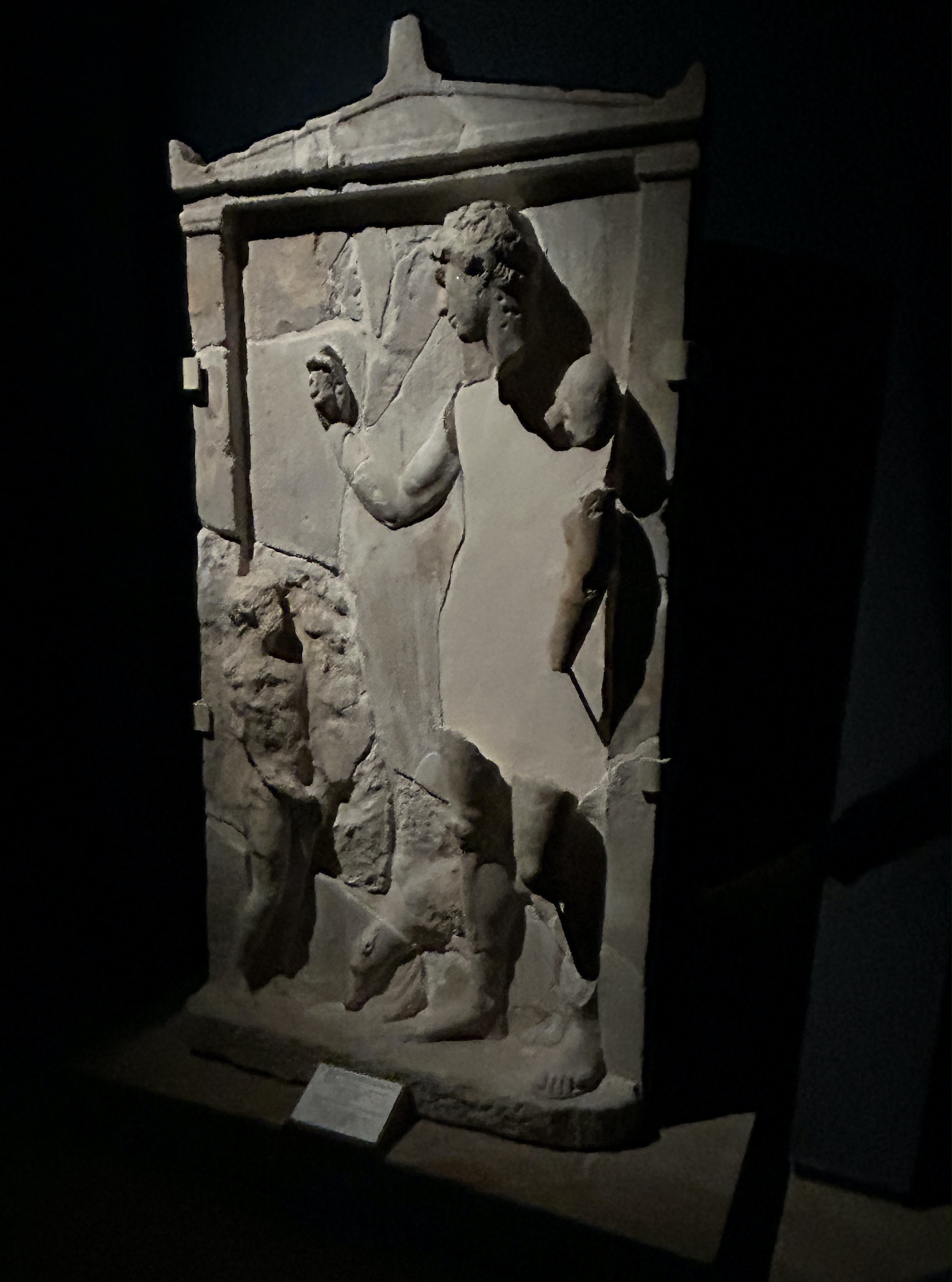
Now this doesn’t look like much, but it was a very important piece of ground at one time. It is the Heroon of Vergina which was built just outside Philip’s tomb. A heroon is literally a place to worship heroes and it is believed that a statue of Philip II once stood here and people would come here to venerate him and his son Alexander. It and the first royal tomb we’ll see was plundered by the forces of the King of Epirus Pyrrhus in around 274 BCE. That is the same guy who became famous for his ‘Pyrrhic victories’.
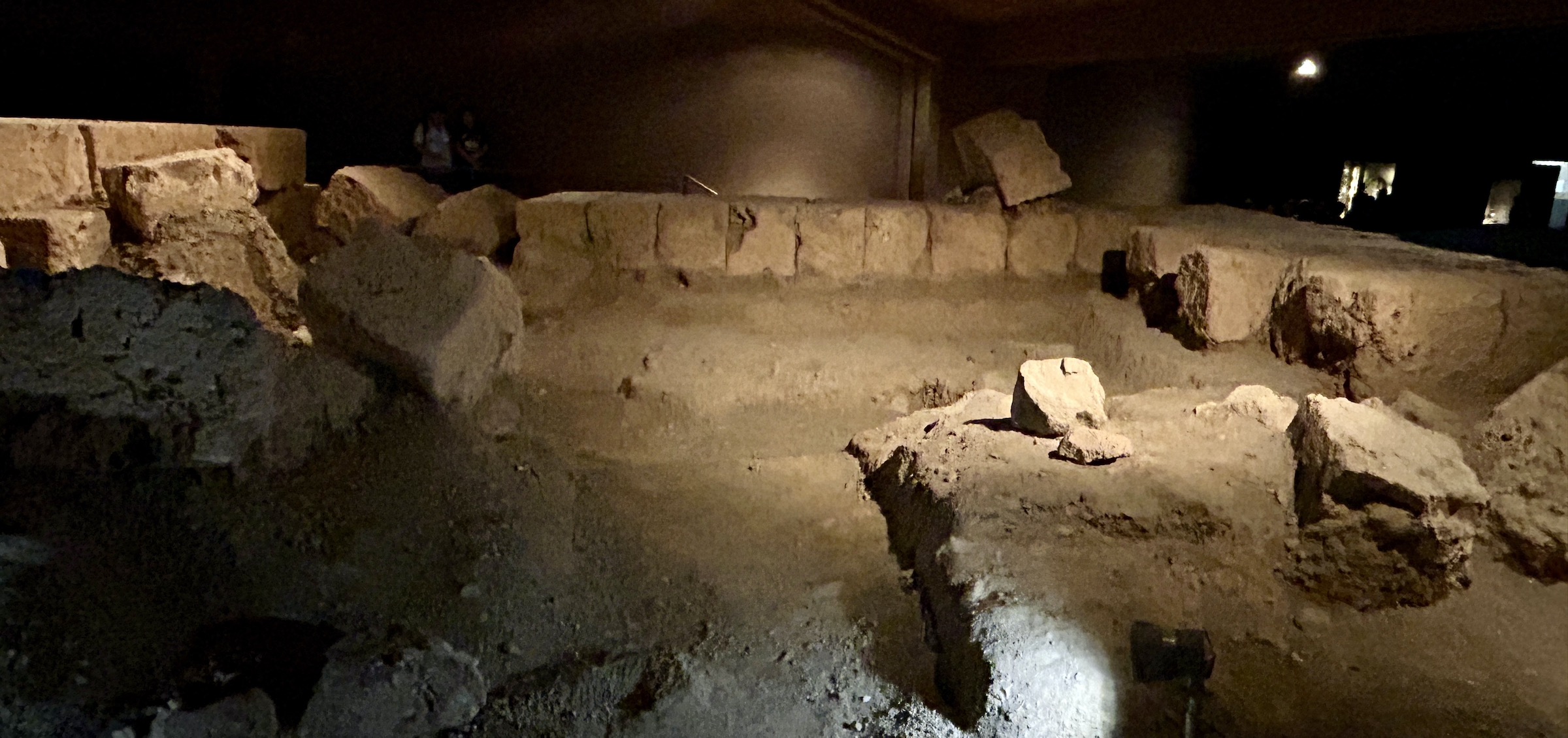
So far what we have seen is nice, but nothing mind blowing and then you come upon this.
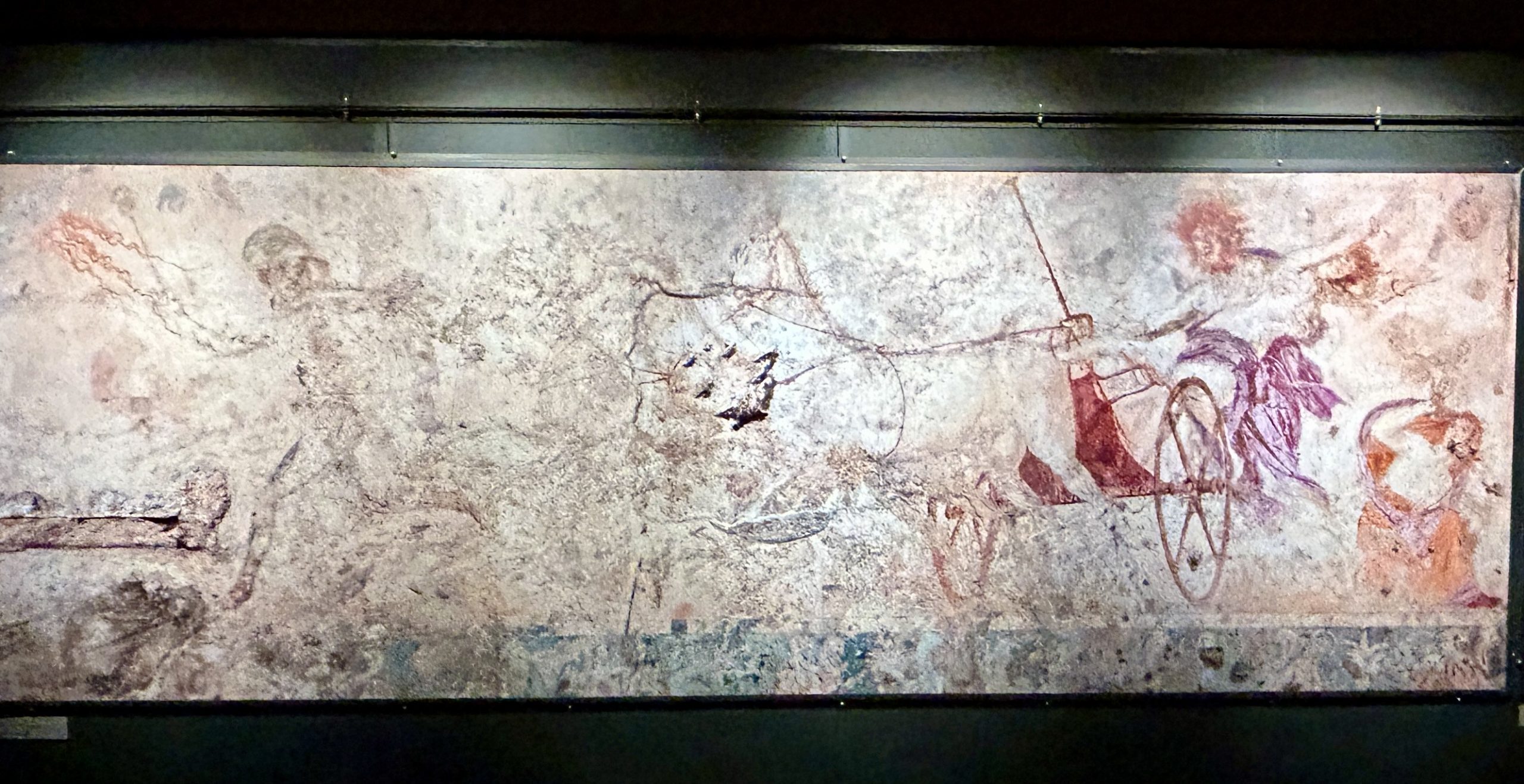
This is a painting of the abduction of Demeter’s daughter Persephone by Hades on the wall of the royal tomb that was looted by the Pyrrhic mercenaries. It is believed that this was probably the tomb of Nikisipolis who was the second wife of Philip and the mother of Thessalonika for whom the city was named. I can’t come remotely close to explaining the power of this painting. Have a closer look.
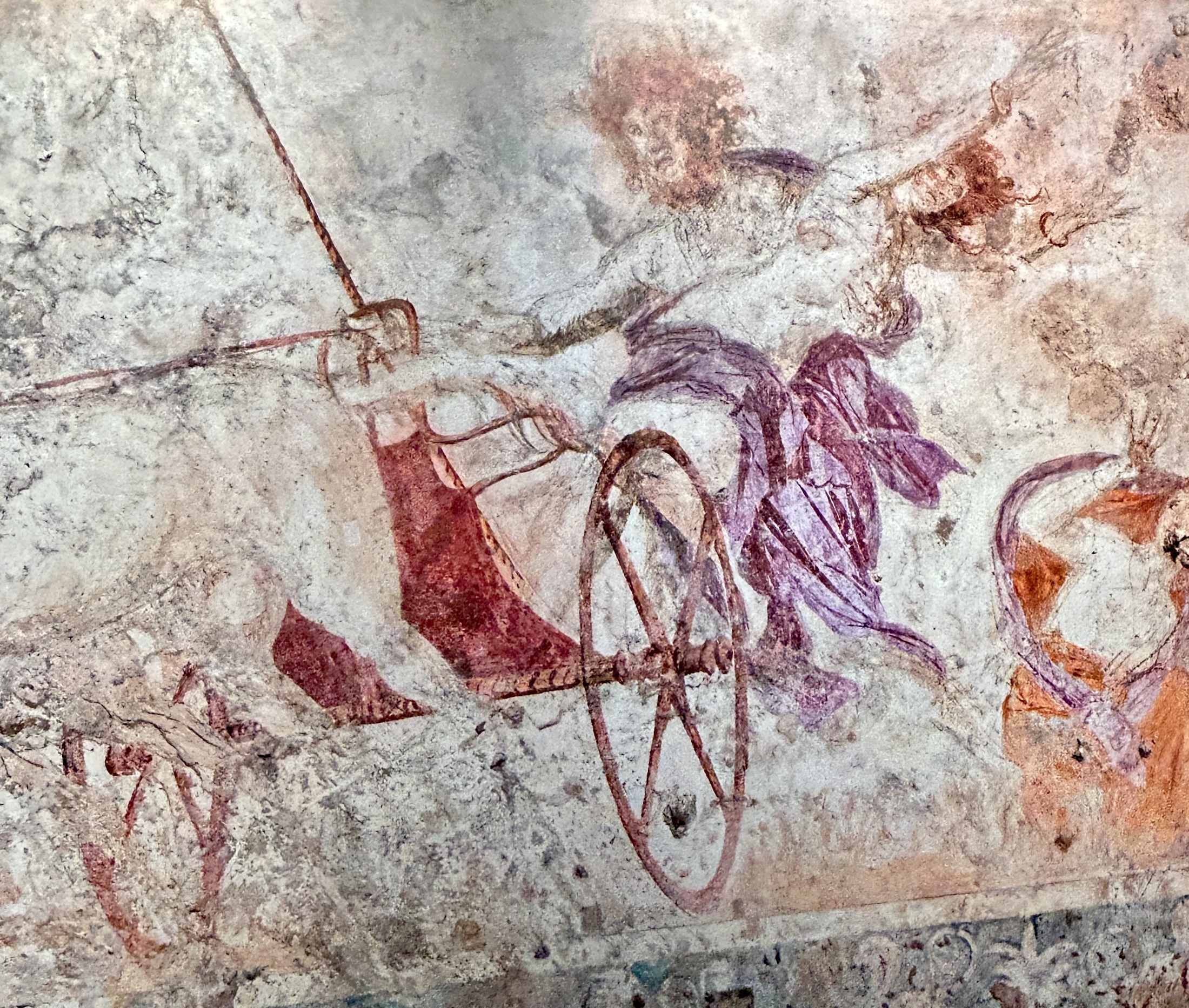
Conventional wisdom states that perspective in painting was only invented during the Renaissance in about 1415. Well when you stand before this painting and literally see Hades tearing right past you at a 45° angle you know that’s bullshit. This one item is worth coming to Vergina to see and we haven’t even got to the unspoiled tombs yet.
This is the site that presented itself to Manolis Andronicos in 1977 when he penetrated the Great Tumulus to this point. He didn’t know it at the time, but he had discovered the tomb of Philip II of Macedon and it had not been opened since it was first closed over 2,300 years earlier.
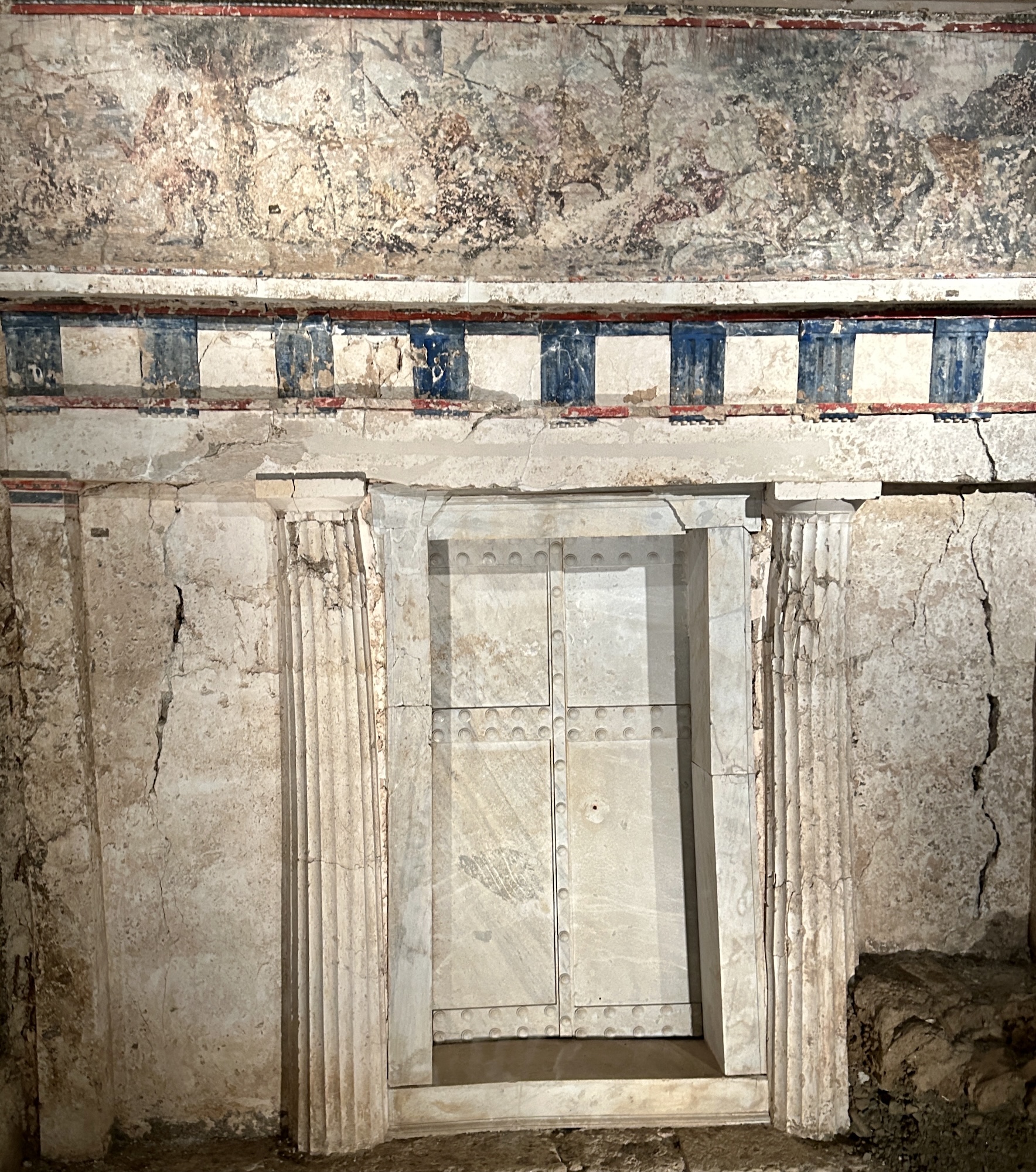
The tomb is still closed to the public, but the objects found inside the two rooms are on display and man are they something. But first I should explain that the Macedonians practised cremation so there are no sarcophagi or mummified remains. What there is are the ashes contained in what is called a larnax, items recovered from the funeral pyre and the personal belongings of Philip. This is the larnax containing Philip’s ashes and the wreath that he wore as a symbol of kingship.
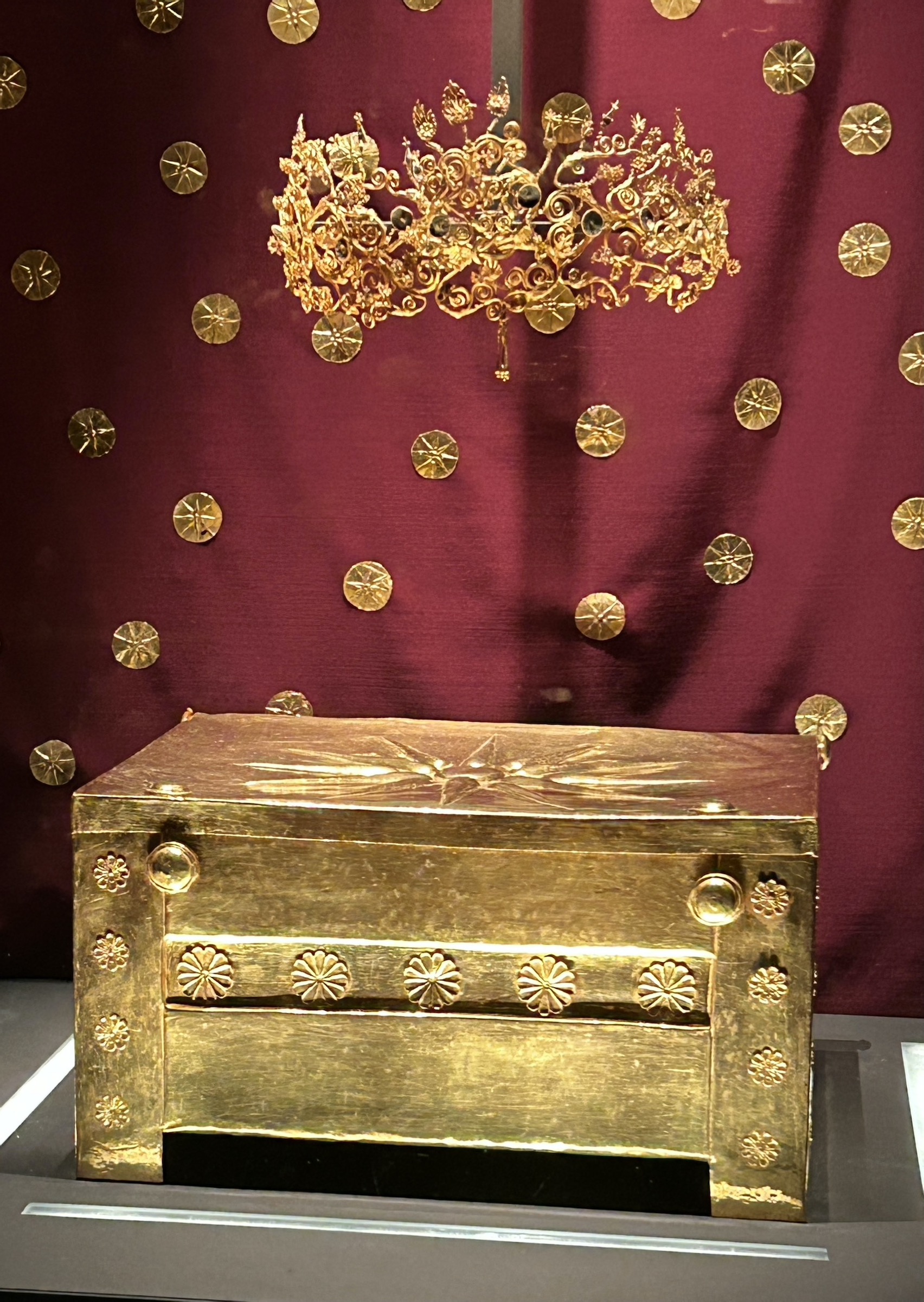
These were some of his weapons. It was the unusual shape of the greaves (lower leg armor) that was one of the factors in determining that this was Philip’s tomb. They were cast for someone who had previously broken their tibia which hadn’t healed properly and that description fitted Philip.
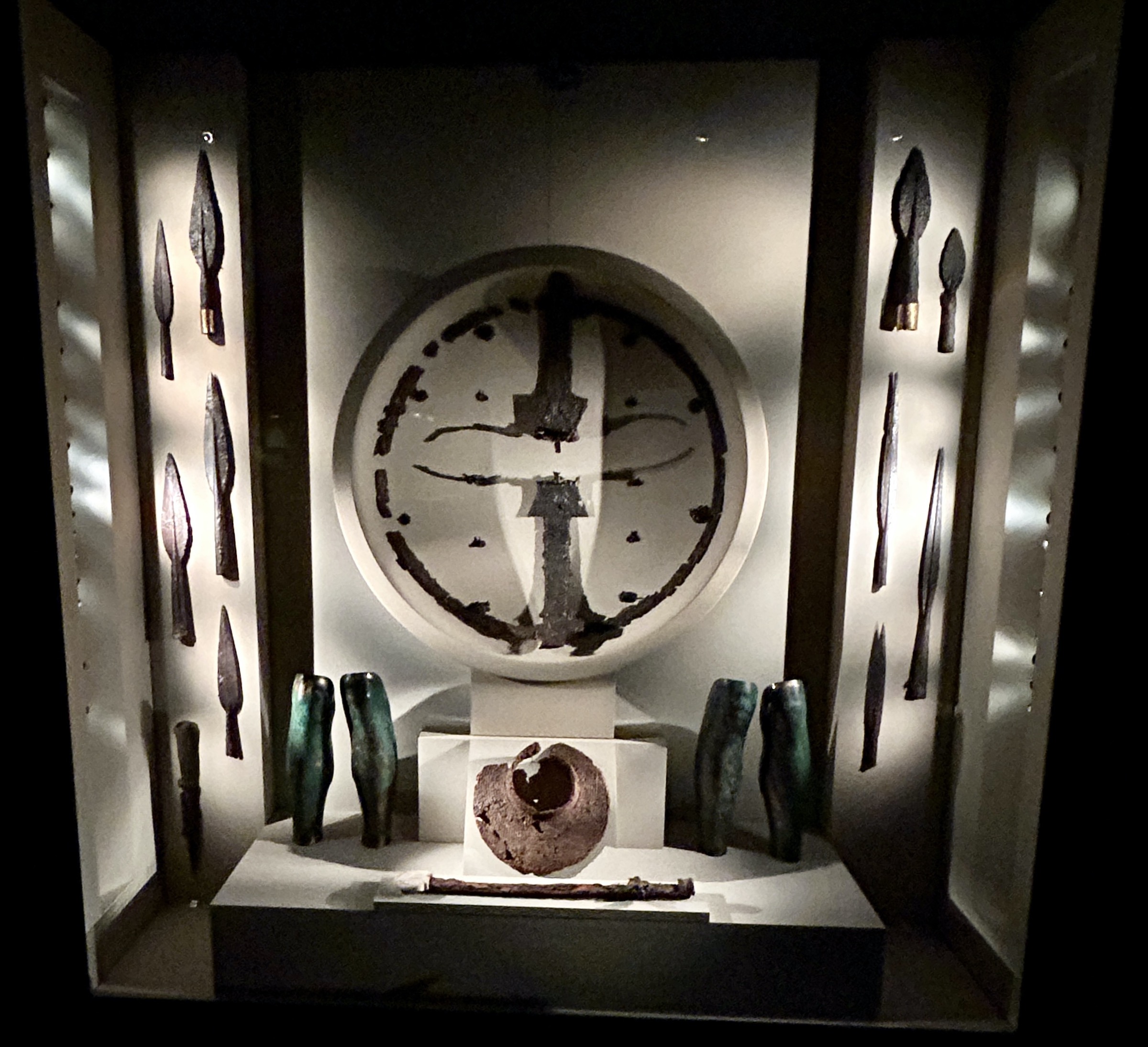
This may look like a modern day frying pan, but it’s actually what is called a patera in which libations would be poured from the ceremonial ewer and offered to the gods while wearing the diadem which features a Hercules knot. This was a knot that combined two ropes in a symbol of undying love and was the source of the saying ‘tying the knot’. Philip did it no less than six times.
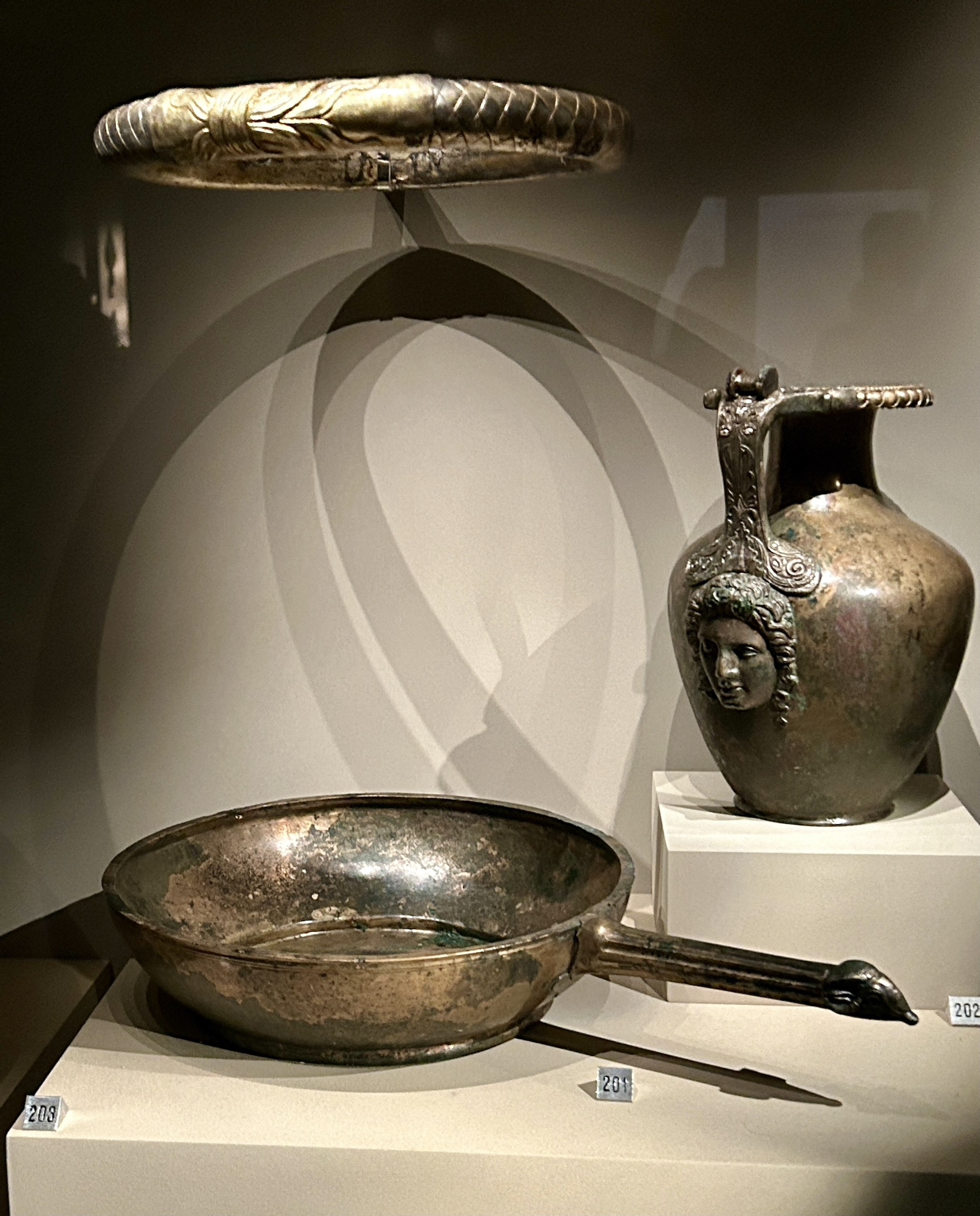
One of the most unusual items on display in the Vergina museum are these ivory fragments that once adorned Philip’s bed frame and yes it was a king sized bed.
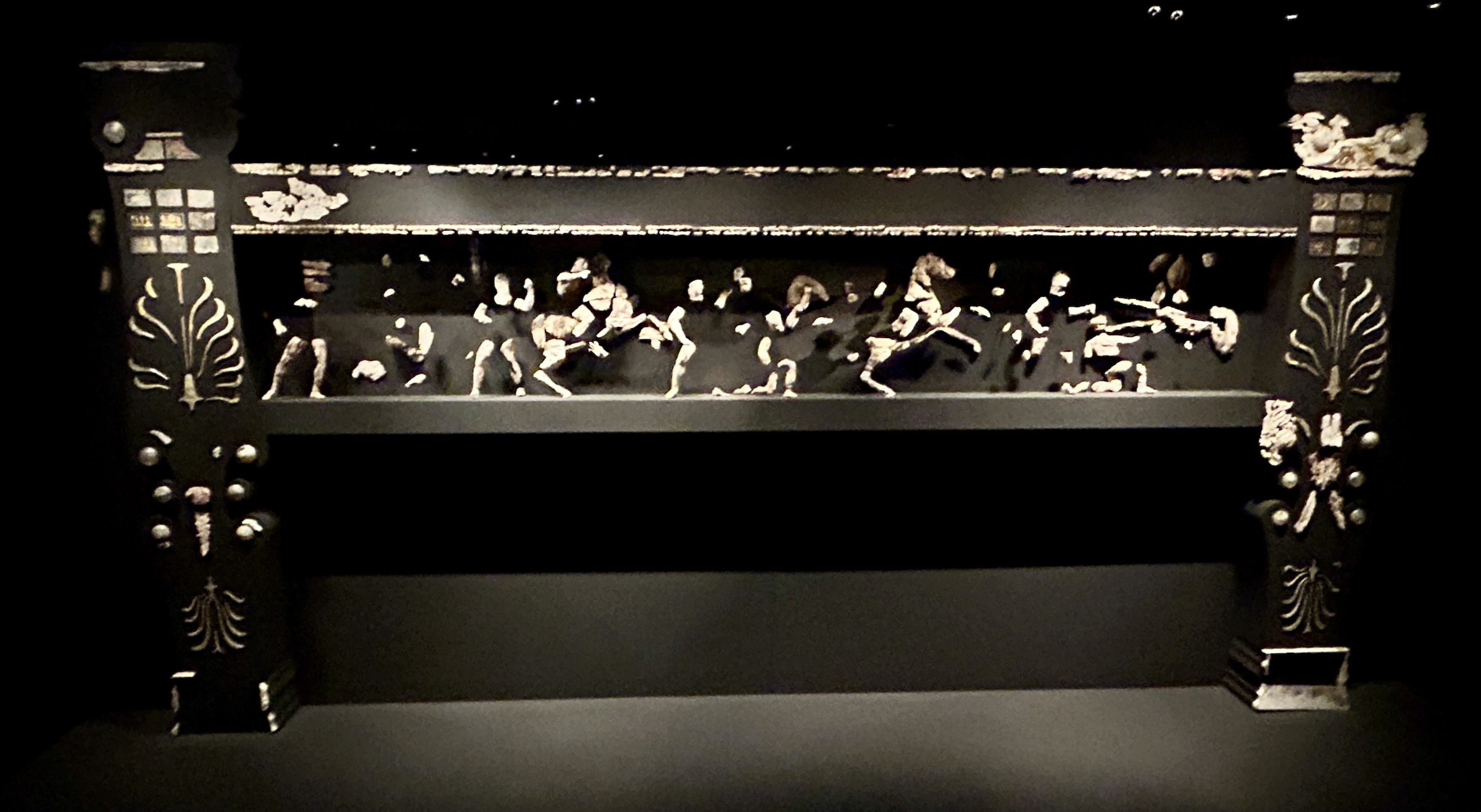
These items are made of pure silver.
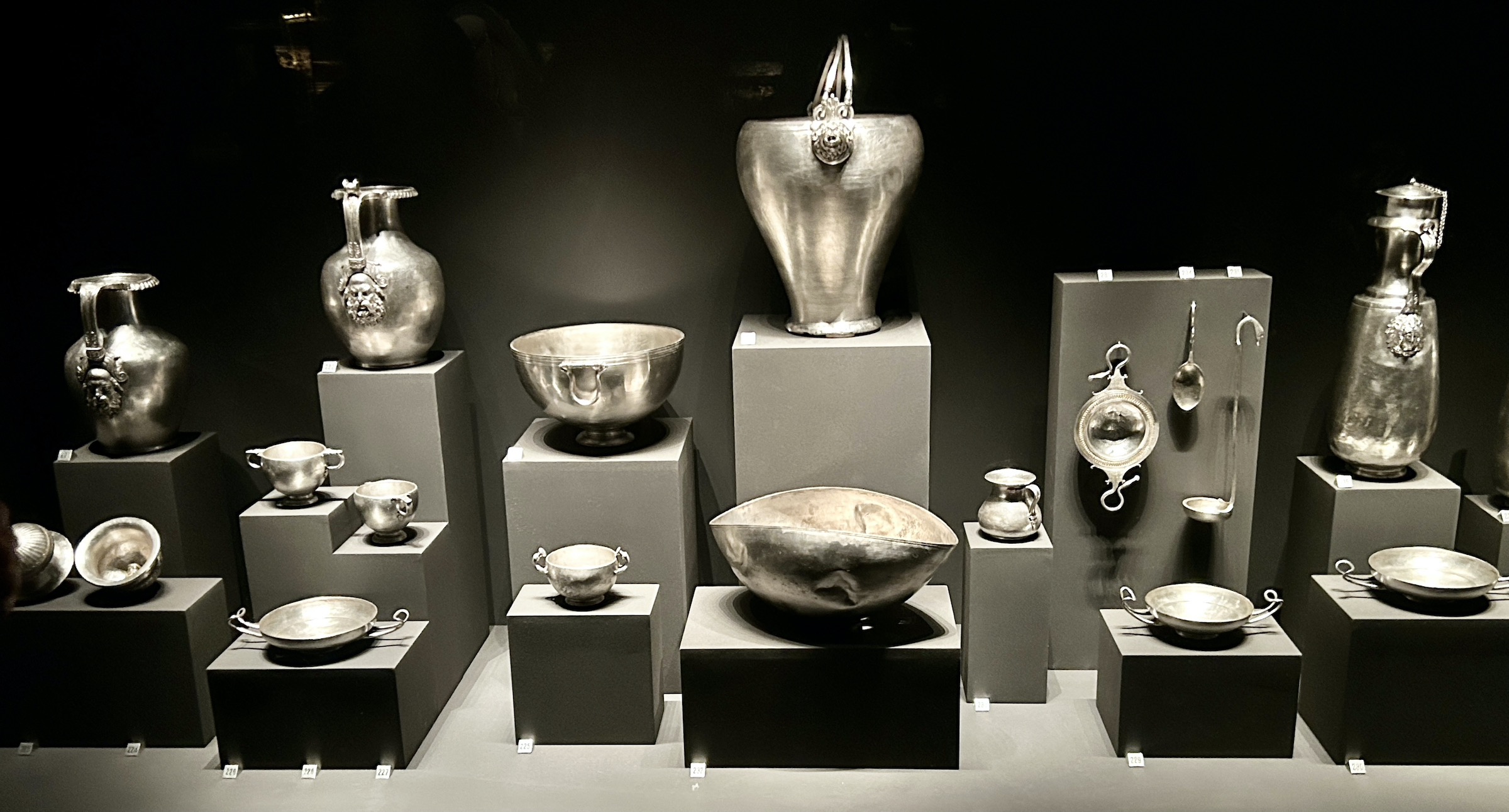
This is the armor that Philip wore on ceremonial occasions.
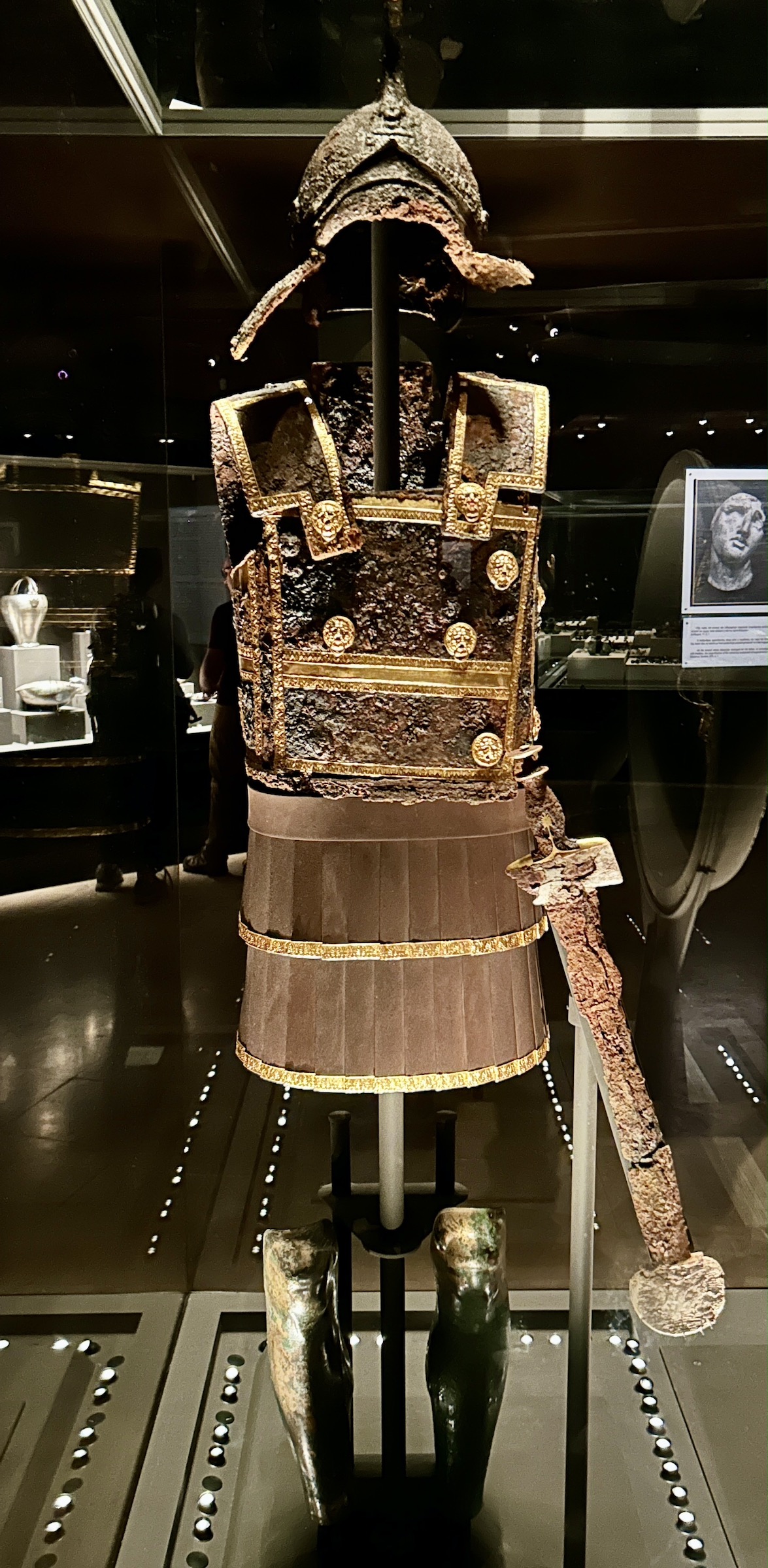
The most remarkable item to me was this shield which is huge and far more impressive than this photo conveys.
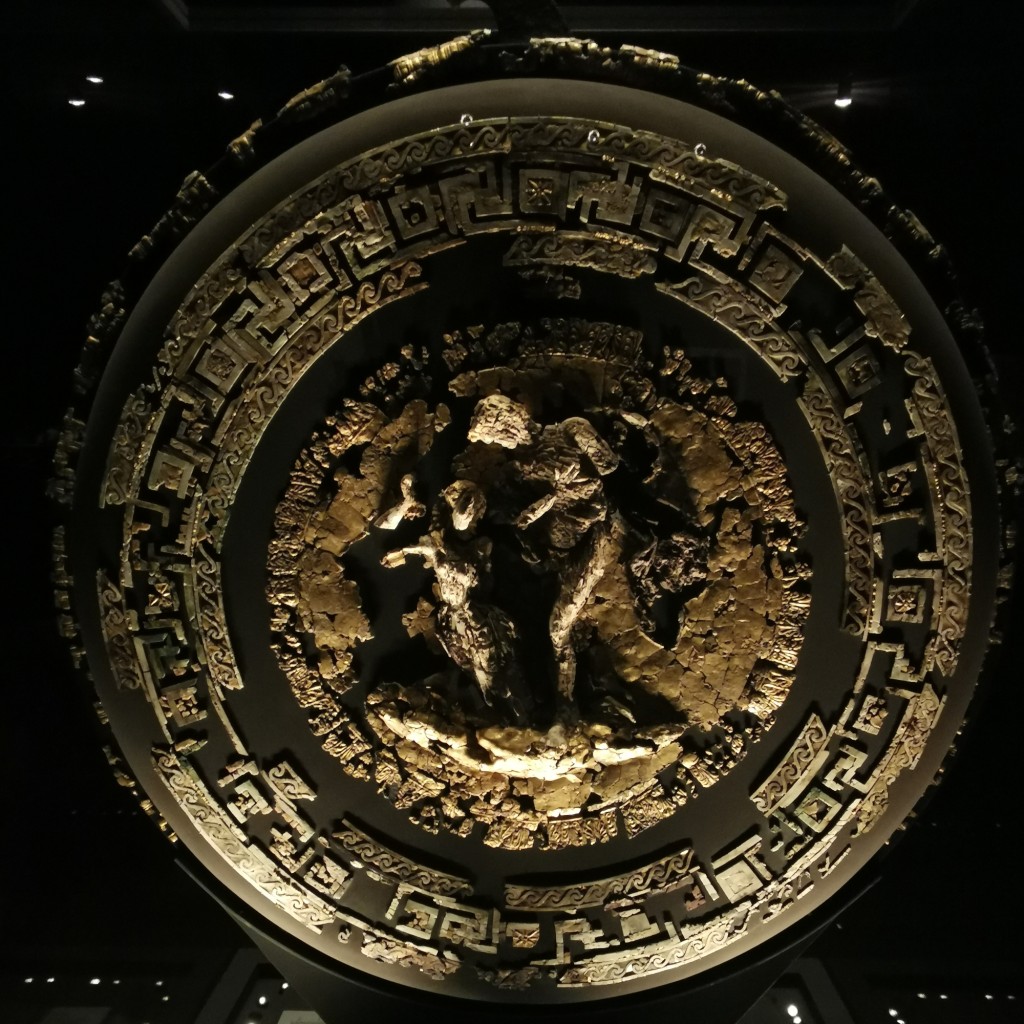
It is made of a combination of gold and ivory called chryselephantine which is the same material that Phidias used to create the gigantic statue of Zeus at Olympia which was one of the Seven Wonders of the Ancient World. It was highly prized and rare. Here is what this shield might have looked like when it was placed in Philip’s tomb. It depicts Achilles slaying the Amazonian Queen Penthesilea, which happened during the Trojan War. Legend has it that Alexander took a shield from the tomb of Achilles which he visited on his way to Persia and that it might actually have belonged to Achilles. Trust me, the aura that this artifact gives off might actually make you believe that this is a direct link to that legendary warrior.
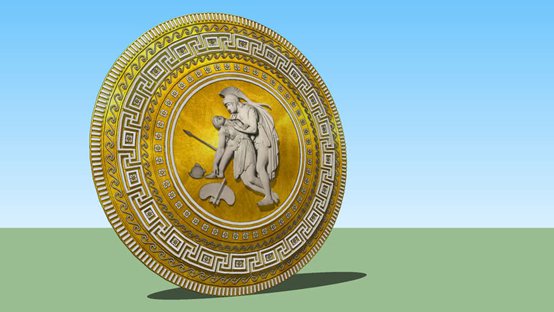
The second unopened tomb at Vergina was built for Alexander IV, the son of Alexander the Great and Roxana his Bactrian second wife. He was born posthumously and never knew his father and spent most of his short life as a pawn in the Alexander succession game being fought between his generals. At age 14 he and his mother were poisoned on the orders of Cassander, the guy who was married to Thessalonika, Alexander’s half-sister.
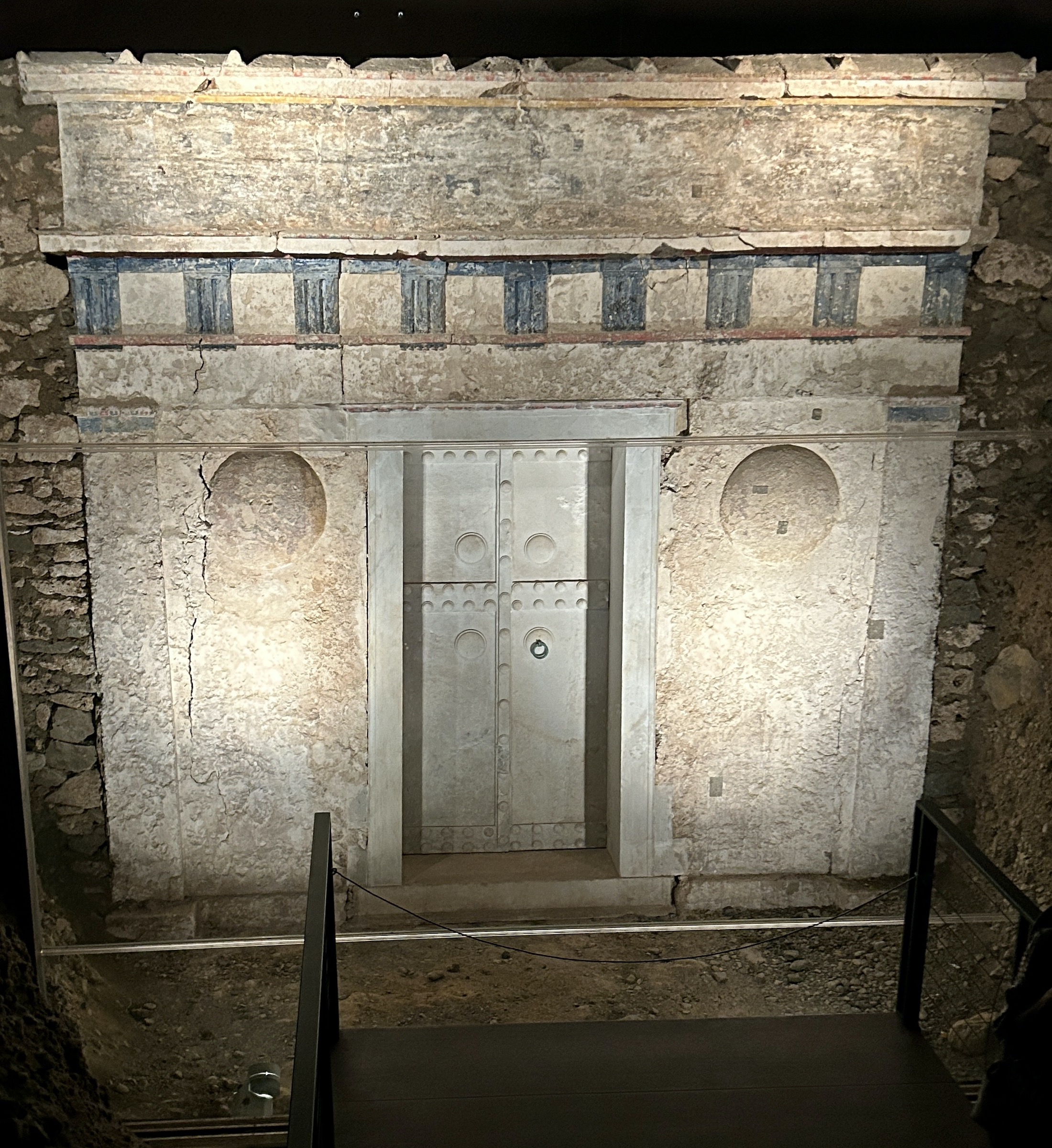
It too contained fabulous riches including his larnax and wreath.
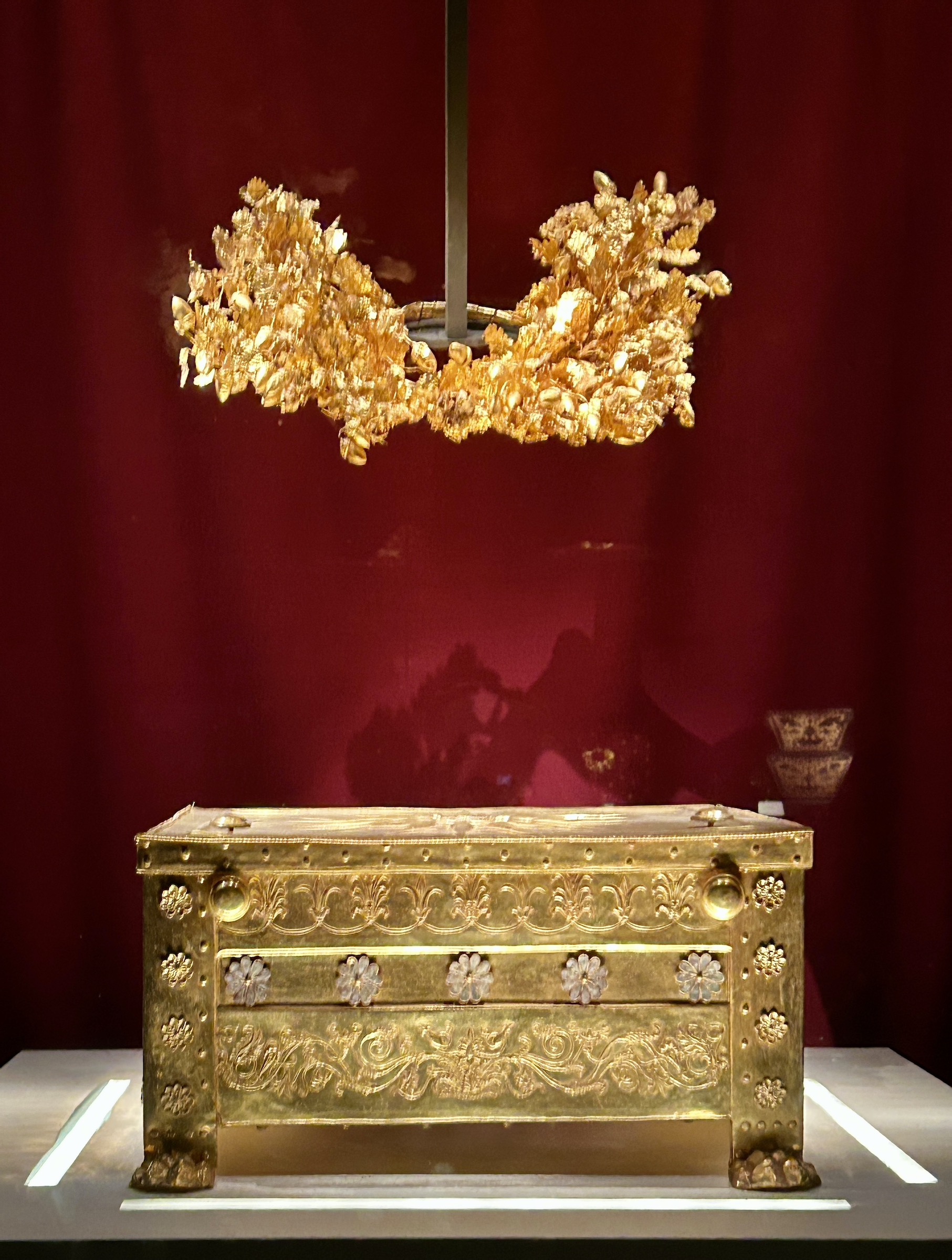
Until 2022 a visit to Vergina would be limited to the Royal Tombs Museum, but in that year the Central Museum of Aigai opened which together is now called the Polycentric Museum of Aigai. Whereas the Royal Tombs Museum is underground and dark, the Central Museum is modern, bright and capacious. You follow this pathway to get there.
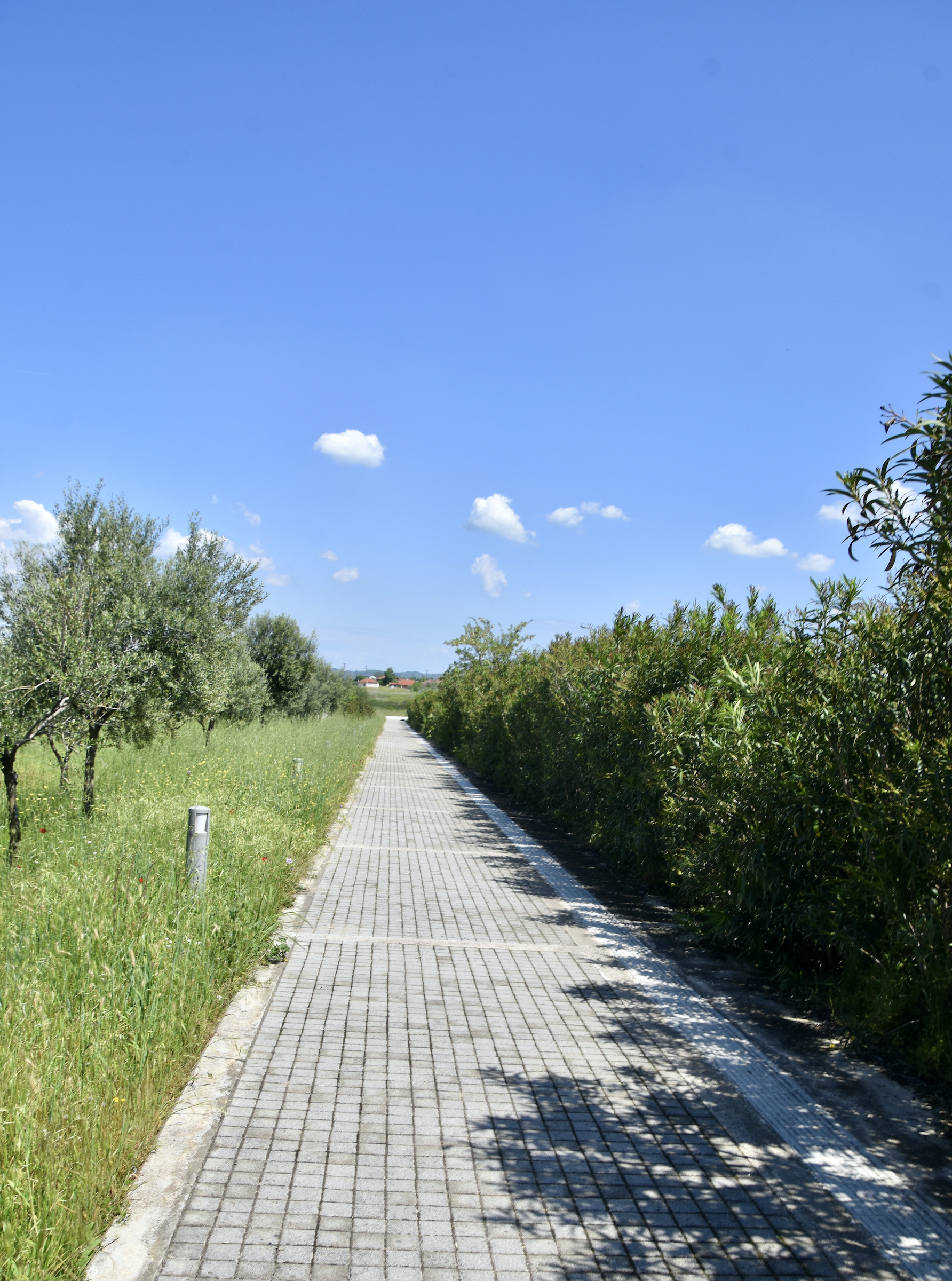
This museum takes what it describes as a ‘holistic approach’ to its mission, whatever that means. It does mean that some of the artifacts are displayed in unusual manners that are not only quite unique, but interesting as hell. Here is a small gallery; who thoughts nails, lamps or pottery could be so interesting? Double click to open a photo and double click again to enlarge.
- Nails
- Lamps
- Tiny Pottery
- Women’s Tools
- Coins of Alexander
- Spear Points
- Tools
- White Pottery
- Miscellaneous Artifacts
This museum also has a fantastic collection of jewelry from the tombs of dead queens of the 8th and 9th centuries BCE long before the time of Philip and Alexander.
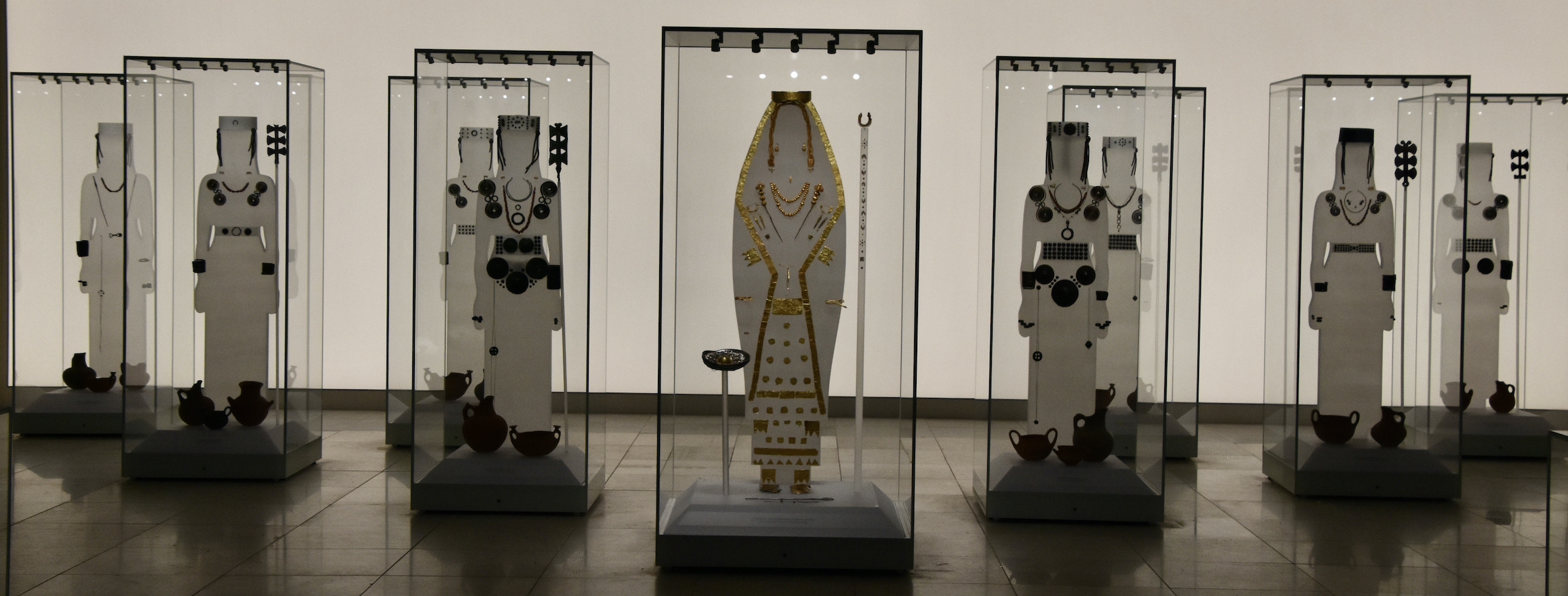
The one exception to the age of these queens is the central figure, the Lady of Aigai that dates from 495 BCE. That’s a lot of gold.
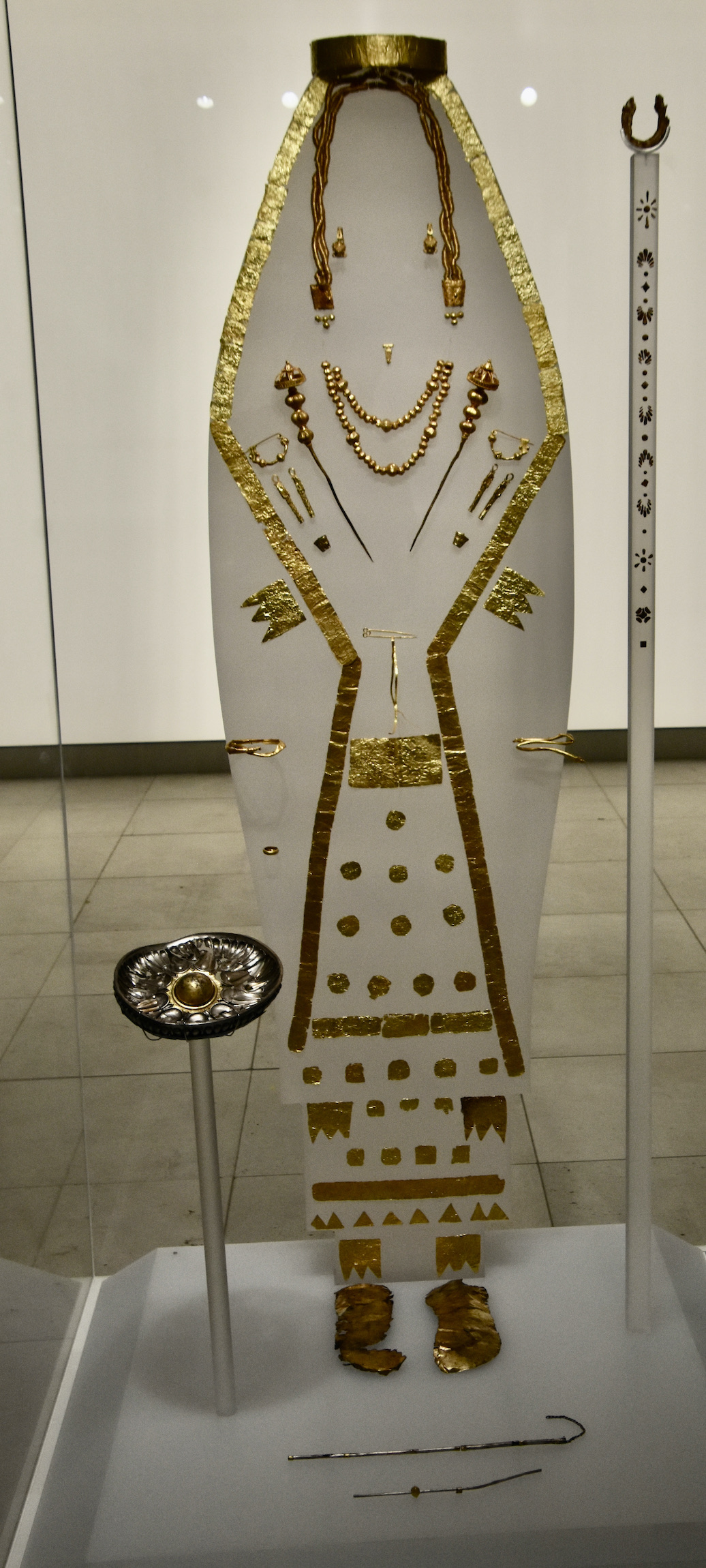
Perhaps the most interesting exhibit from an historical perspective is this statue of Eurydice who was mother of three kings including Philip II and grandmother of Alexander. If your familiar with the great BBC TV Series I,Claudius you’ll remember Livia, wife of Augustus who is portrayed as absolutely cunning and ruthless, doing anything to advance the interest of her one son Tiberius. Well Eurydice did it three times and was involved in more intrigues than the fictional ones of Livia.
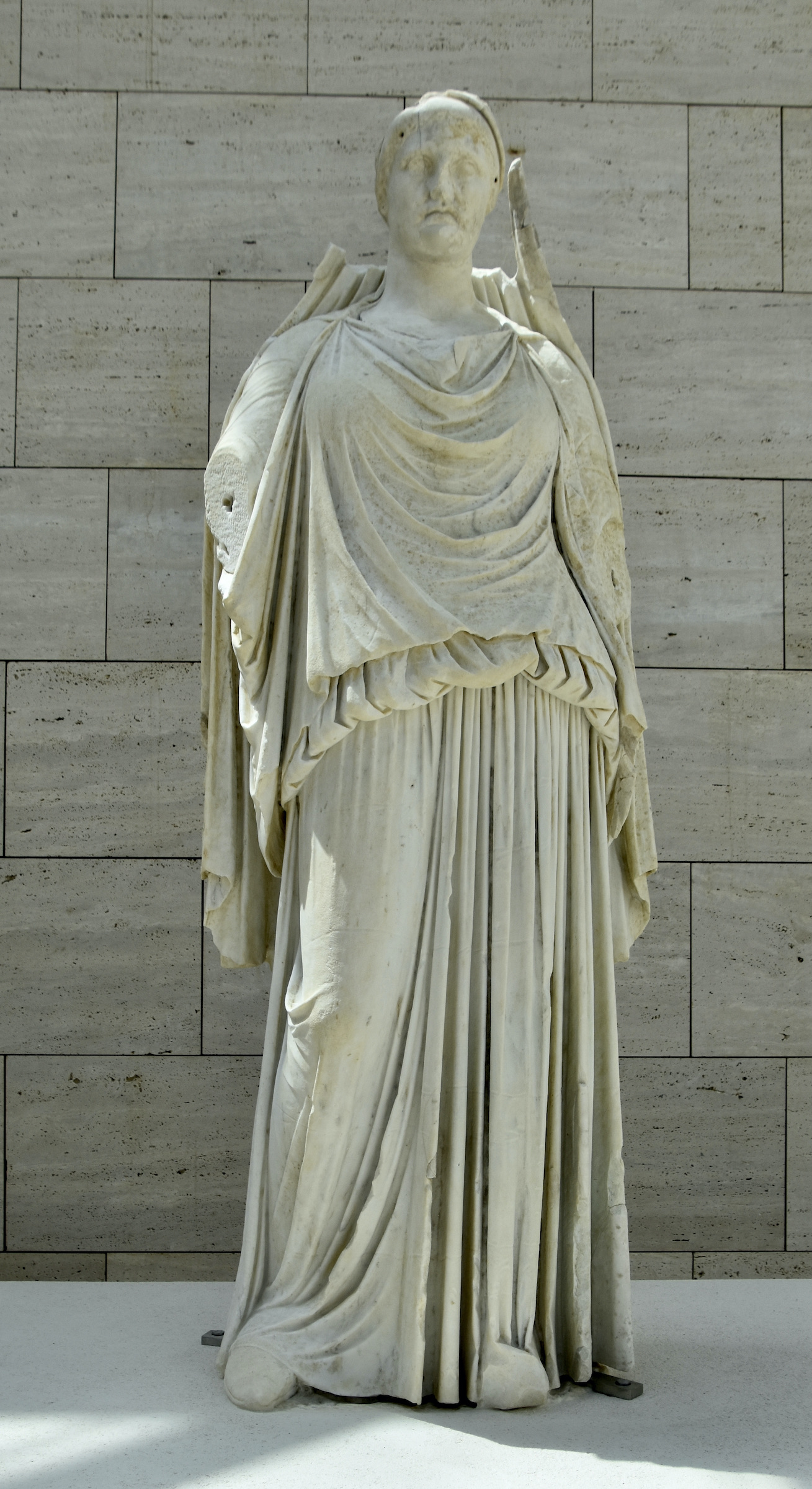
On that note we’ll end our tour of Vergina which, if Pella was a bit of a disappointment, Vergina more than made up for, in spades. In the next post we’ll go to the sanctuaries of Dion and then the abode of the Greek gods, Mount Olympus, another place on my bucket list that is getting crossed off on this great Via Egnatia tour.


